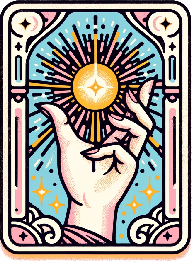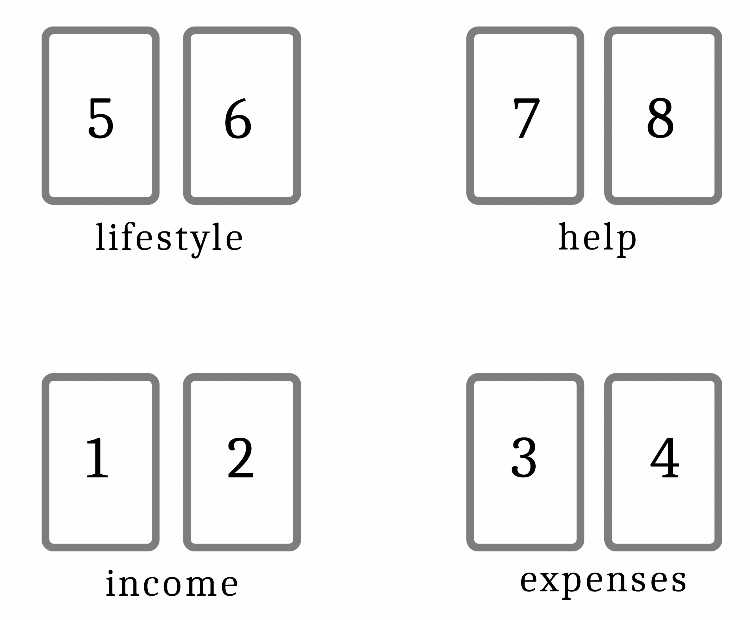
The spread the "Grand Tableau" is maybe *THE* spread to practice the Petit Lenormand, it is its letters of nobility, and makes the Petit Lenormand interesting and positions it as a Tarot challenger. If you don't know what the "Grand Tableau" is, in one sentence, it is a spread using all 36 cards of the deck, in 4 lines of 8 cards + 4 mood cards at the bottom (in cartouche) of the tableau. (To learn more, read my article about the "Grand Tableau").
However mastering the "Grand Tableau" spread can be difficult, much more so than learning the meaning of the Lenormand cards, which by the way have simple symbolism. And when coming from the world of Tarot, the "Grand Tableau" can be a big step to take. Also it can be very useful and relevant to start practicing the Petit Lenormand with 3, 4, 5 slot draws to get familiar with the deck, or to use the Petit Lenormand in a quick and easy way during a flash spread.
Can we use the Tarot readings for the Petit Lenormand ?
Yes of course, and if you come from the Tarot universe, you can pick up your favourite draws. It's probably a good optic to start the Lenormand. For example, I've seen cartomancers use the Cross spread with the Petit Lenormand. However, with practice, you will find that the Petit Lenormand is much more polarised, much less neutral, and also less generalist than the Tarot. In fact, the Lenormand draws are more direct, more instantaneous, more "cash", more "raw" than the Tarot. There is an immediacy to a Lenormand print that is not necessarily found in a Tarot print which is usually more constructed.
Are there any specificities for the Petit Lenormand draws ?
Yes, because as I said above, the Petit Lenormand is drawn differently from the Tarot, the "Grand Tableau" spread being the perfect example. You must take into account the following elements :
- The Lenormand cards have a simple symbolism. If you want to nuance and deepen your reading, you will need to spread more cards than you do with a Tarot deck.
- There are two special cards in the Lenormand system : 28 - The Man and 29 - The Woman which have no equivalent in the Tarot. In fact, with the first two draws on the love life, the occurrence of the 28 or 29 card can disturb the interpretation.
- There is no such thing as a right-side-up or wrong-side-up interpretation in Lenormand. Historically, the distance between the cards is used to evaluate their polarity.
With these few elements that I have just mentioned, one can easily understand that drawing the Lenormand as one draws the Tarot can be contradictory. Also the draws below, even if I consider that they are the best draws to approach the Lenormand from a Tarot vision, do not represent "the original way" to spread the Lenormand. Historically, we use draws without slots ! And I remain convinced that this is the best approach to using the Lenormand. The "real" Lenormand spreads are more thoroughly explained in my article How to read Petit Lenormand.
Why two cards per slot ?
As I have already mentioned, the Petit Lenormand is very polarised. Traditionally, the polarity of cards depends on the distance between them, but this method is becoming obsolete, and cannot be used with slots. If you only keep one card per slot, you may get very "raw" results, either all good or all bad. I know it's good for show and the "guru" effect, but I'm not Miss Lenormand and neither are you, and in modern fortune-telling it's good to be neither triumphant nor alarming, and to make nuanced and open readings. Also having two cards per slot will allow for " duos " in which the cards can counterbalance each other, allowing for a balanced interpretation without being neutral or bland.
Thus, if you wish to adapt your Tarot draws to the Lenormand, I systematically advise you to use "duos" of cards for each slot, for the reasons I just mentioned. Since the Petit Lenormand system contains only 36 cards, this has an impact on the number of slots you can use in your deck. So a 5 slot spread you draw 10 cards, a 6 slot spread you draw 12 cards and a 7 slot spread you draw 14 cards. Note that a 12-card spread is already a third of the Lenormand deck. I therefore advise you to limit yourself to draws of 6 slots maximum, because beyond that I feel that too many cards are drawn on the table, which distorts the probabilities, the interpretations become repetitive or similar because the same cards are drawn from one consultant to another. I find that the same phenomenon occurs when the Tarot is drawn with only the series of 22 trumps (the Major Arcana), which is often the case in France with users of the Tarot de Marseille (personally I always draw with the 78 cards of the Tarot de Marseille).










